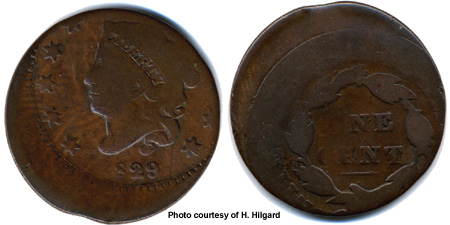MINTERROR NEWS.COMTM
Bringing the latest mint error news to the collector. Also featuring Die Trials, Patterns, Test Pieces, Numismatic Rarities, Currency Errors and Discoveries from the U.S. Mint.

|
|
|
News

Is a “Double Error” Large Cent More Valuable?
 A nice group of error U.S. Large Cents, including some 26 off center pieces
dated from 1795 through 1855, was sold by Superior Galleries in the ANA auction sale of August 2002. One of these off centers, the 1829 piece shown below, is a “double error”, possessing an additional error feature, namely the clip that appears on the coin at approximately 6:30 on the obverse and 11:30 on the reverse. A nice group of error U.S. Large Cents, including some 26 off center pieces
dated from 1795 through 1855, was sold by Superior Galleries in the ANA auction sale of August 2002. One of these off centers, the 1829 piece shown below, is a “double error”, possessing an additional error feature, namely the clip that appears on the coin at approximately 6:30 on the obverse and 11:30 on the reverse.

 How rare is this “double error” large cent in comparison to “single error” off center large cents? To the best of my knowledge, no one has made a study of auction records and sales records that would help to answer this question. But even without this information, we can estimate the rarity by starting with some assumptions. First, we will assume that punching out the blanks (where a mistake may lead to a clipped blank) and striking the coins (where a mistake may lead to an off center) are independent activities in the sense that a clipped blank isn’t more likely to become an off center piece. Second, we will assume that less than 1 in 100 existing large cents are struck off center, and that less than 1 in 100 existing large cents have clipped planchets. If our assumptions are correct, the chance of finding a double error like this one is less 1 in 10,000 large cents (1 in 100 times 1 in 100). Wow, what a rarity! How rare is this “double error” large cent in comparison to “single error” off center large cents? To the best of my knowledge, no one has made a study of auction records and sales records that would help to answer this question. But even without this information, we can estimate the rarity by starting with some assumptions. First, we will assume that punching out the blanks (where a mistake may lead to a clipped blank) and striking the coins (where a mistake may lead to an off center) are independent activities in the sense that a clipped blank isn’t more likely to become an off center piece. Second, we will assume that less than 1 in 100 existing large cents are struck off center, and that less than 1 in 100 existing large cents have clipped planchets. If our assumptions are correct, the chance of finding a double error like this one is less 1 in 10,000 large cents (1 in 100 times 1 in 100). Wow, what a rarity!
 So you think it sold for a bunch of bucks? This coin (lot 2509) sold for just 33% more than an 1830 (lot 2513) that lacked a second error feature but was otherwise very comparable. These coins were approximately the same grade (good), had similar surfaces (nice), and were about the same percentage off center (20%). Both pieces were purchased by the same large cent dealer. So you think it sold for a bunch of bucks? This coin (lot 2509) sold for just 33% more than an 1830 (lot 2513) that lacked a second error feature but was otherwise very comparable. These coins were approximately the same grade (good), had similar surfaces (nice), and were about the same percentage off center (20%). Both pieces were purchased by the same large cent dealer.
 What to make of the relatively small premium paid for the double error 1829? One factor may be that these double error pieces aren’t as rare as these numbers would suggest because our assumptions are off. But probably more important, no one seems to collect large cent “double errors” as a category, which is a way of saying that the marketplace just doesn’t place much value on rarity of this kind. All of which adds up to good news for error collectors who don’t have to empty out their bank accounts in order to own and enjoy an occasional coin with more than one error feature. What to make of the relatively small premium paid for the double error 1829? One factor may be that these double error pieces aren’t as rare as these numbers would suggest because our assumptions are off. But probably more important, no one seems to collect large cent “double errors” as a category, which is a way of saying that the marketplace just doesn’t place much value on rarity of this kind. All of which adds up to good news for error collectors who don’t have to empty out their bank accounts in order to own and enjoy an occasional coin with more than one error feature.

 |
|
|
|
|
|
Copyright Ⓒ 2003 minterrornews.com. All rights reserved. Legal notice.
|
|
|
|